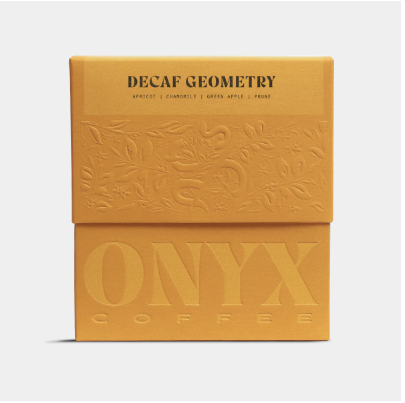
About this Coffee
Rest easy with our newest decaf offering in the form a limited-quantity Decaf Geometry blend. This decaffeinated blend is the product of two extraordinary coffees: our honey-processed Colombia Aponte Village, and a washed Swiss Water processed coffee from Bensa, Ethiopia. This blend is greater than the sum of its parts, mirroring our crowd-favorite Geometry Blend, but with none of the caffeine.
Admit it—when you were a kid, you didn’t think you would be thinking of Geometry as an adult. But we have turned the tables on you. But don’t worry, our Geometry will not stress you out like middle school. Great as a filter coffee or an espresso, this blend has become our answer for everything.
Q: Which coffee do you want for filter coffee?
A: Geometry
Q: What coffee should we have as an espresso?
A: Geometry
Q: Does my favorite blend from Onyx have a decaf counterpart?
A: It does now.
Q: The Pythagorean theorem is a formula used in which form of mathematics?
A: Geometry
This coffee is ridiculously good and approachable while also remaining complex. As a decaf offering, it consists of our Honey-Processed Aponte Village from Colombia, decaffeinated from the EA process, and a Swiss-Water processed coffee from Bensa, Ethiopia. Together, these coffees mirror the complex yet floral nature of our Geometry blend, with none of the caffeine.
EA DECAFFEINATION
Sugar cane ethyl acetate or commonly known as EA decaf is a natural process of decaffeinating coffee. It is usually found in Colombia where sugar cane is readily available and starts with making molasses from sugar cane. Once created, it sits in vats to ferment. The bacteria produce acetic acid, much like fermenting coffee, and at the peak of fermentation, alcohol is added to make something called ethyl acetate.
For it to be applied to coffee first, the green coffee is steamed in tanks to elevate the moisture level — the beans swell, which allows the extraction of caffeine. Ethyl acetate is added to the mixture, and it dissolves the caffeine in the coffee. The coffee is then washed with water and laid to dry. In theory, the coffee should reach the same moisture content as it arrived in, which is somewhere between 11-12%. The most important part of EA coffee, and why it tastes so sweet, is it avoids high pressure and high heat, which degrades coffee quickly. This allows the natural terroir flavors to come through, making it a sweet and bright decaf.
SWISS WATER PROCESS DECAF
There are several processes that coffee can undergo to reduce or completely take away the caffeine, and the Swiss Water Process has been a staple amongst decaffeinated coffees for years. It begins with something they call GCE, or green coffee extract. This is crucial to the decaffeination step, and is followed by a rehydration of the coffee which allows for the coffee seeds to reach optimal levels for extraction. The caffeine is then drawn out with the GCE, which is recirculated through the coffee for 8-10 hours until the seeds reach .01% caffeine content. The coffee is then dried back to optimum levels for roasting and rebagged and sent back to the roaster.